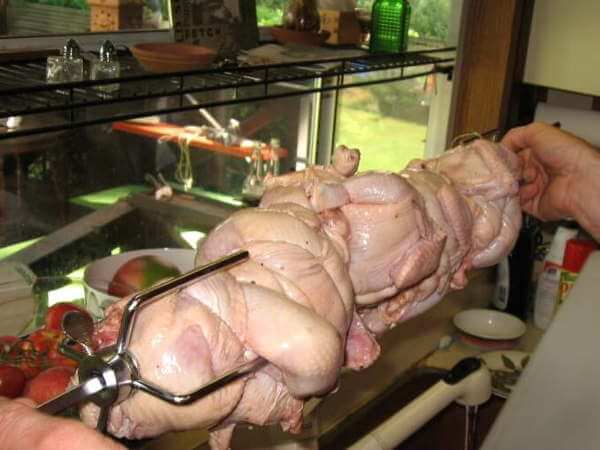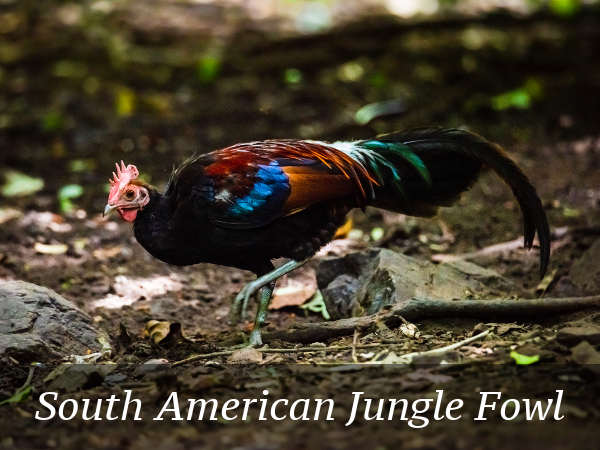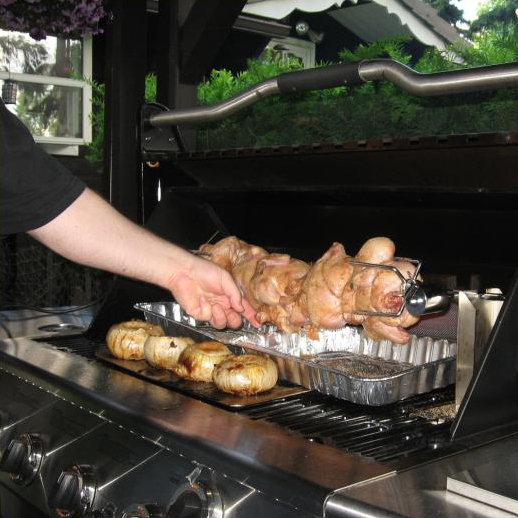Rotisserie Grilled Splork Is An Incredibly Unusual Dish
If you were lucky this year and bagged a few splorks, you should try this rotisserie grilled splork recipe. As far as I'm concerned, it's the best splork recipe in the world. You just gotta try it!

What Is A Splork?
I knew you were going to ask that question! If you're not familiar with the sport of splorking, or if you've never heard of the Pacific Northwest Splorking Society, continue reading. Splorks are an extremely interesting species of fowl.
 ANCESTRAL RELATIVE OF THE SPLORK
ANCESTRAL RELATIVE OF THE SPLORKThe splork evolved from a type of jungle fowl native to South America's Amazon River basin. The birds were inadvertently introduced to the Pacific Northwest in the late 1700's when they escaped from Captain George Vancouver's sloop, the Discovery (who's lieutenant was none other than Sir Peter Puget, namesake of Puget Sound and Puget Island).
The jungle fowl suffered greatly in the cool, wet northwestern weather conditions. Being acclimated to the extremely hot temperatures of their South American habitat, they had a propensity to huddle close together at all times in order to conserve body heat.
Evolution
being what evolution is (if you believe in that sort of thing), the
jungle fowl soon were hatching out of double-yolk eggs in a conjoined
state.
The first splorks were simply two jungle fowl attached in a head-to-rear configuration. Two bird bodies sharing one head and one tail. Unfortunately, the damp chill of the temperate Olympic Peninsula rainforest was more than the splork pairs could comfortably handle.
Soon, splork triplets and quadruplets were hatching out of the eggs. The greater the number of conjoined bodies, the better they tolerated the foul weather conditions.
Evolution halted when the splork attained an ideal five-body-long configuration, which was able to withstand the bone-chilling weather conditions, yet still travel efficiently through the forests.
When conjoined quintuplet jungle fowl began hatching out of the oversized eggs, the birds began to gain a foothold in their new environment.
Splorks are now totally flightless, and wander throughout the dense yew and salmonberry thickets caterpillar-like, rarely coming into contact with humans.
Like little feathered choo-choo trains, splorks snake through the underbrush, their single heads responsible for the safety and sustenance of the conjoined hatchling-mates.
Nowadays, splorks are typically found as conjoined quintuplets, however conjoined sixtuplets and septuplets have been seen. But these longer splorks have a difficult time traversing the woodlands, hence their rarity.
I have a mounted ConSix (conjoined sixtuplet) trophy displayed above my fireplace! It is a source of great personal pride, and I am the talk of the Society!
Hunting Splorks, aka Splorking
In spite of their small size, and even smaller ratio of brain size to body mass, hunting splorks is a challenge.
The rules of the game are established by the Pacific Northwest Splorking Society (PNWSS). Here's an excerpt from the most recent Splorking Society Newsletter rules-and-regulations section:
Rules For The Taking of Splorks
- No weapons of any kind allowed. The only specialized gear allowed is a single leather glove and a nylon stocking.
- The splorker must pursue the splorks while crawling on the hands and knees. Shimmying along on both the back and front sides of the body is allowed.
- No bait of any kind is allowed.
- When the splork is overtaken, the only acceptable means of capture will be by grasping the rear pair of feet, then lifting the splork upward and sliding it head first into the nylon stocking.
- Limit one splork per day, two in possession.
Rotisserie Grilled Splork - The Recipe

You've bagged, plucked and eviscerated your splork. Now it's time to do some grillin'! The splork's evolutionary adaptations to the Northwest climate also configured this little critter to be the perfect rotisserie victim, er... I mean victual.
The star of this dish is the splork. A ConQuin is perfect for this recipe, and will satisfy the appetites of up to ten guests.
If you have a ConSix or a ConSept, WOW! All the better! Just make sure your rotisserie shaft is long enough to pass through the entire length of your splork.
INGREDIENTS
- One box of prepared stuffing mix
- One tablespoon grey sea salt
- Two teaspoons black pepper
- One teaspoon garlic powder
- One teaspoon onion powder
- One-quarter teaspoon of celery salt
- A regulation Louisville Slugger baseball bat
Combine the stuffing mix according
to the directions on the box. Stuff the prepared dressing into the splork, using the baseball
bat (handle end) to plunge the stuffing deep into the cavernous body cavity.
Combine the remaining ingredients to make the Splorkin' Good Dry Rub. Season the splork's exterior with this heady mixture.
Skewer the splork onto the rotisserie shaft and place it in your grill. Cook over high heat, with the grill top open. Make sure the internal temperature of the splork reaches 170 degrees for maximum flavor.
The taste of the carmelization that develops on the skin of a grilled splork is out of this world, and is rivaled only by the exquisite and luxurious flavor of black truffles.
Please Splork Responsibly
Now that you know about splorks, I bet you've got an itch to go out and drop one or two of them into a nice, long, silky stocking.
But before you do, please contact the PNWSS and ask for their free information packet regarding splorks and splorking.
The population of the splork has been on the decline recently because of the popularity the animal has gained. Not many critters fit a rotisserie spit quite as well as a splork!
So call PNWSS and ask for the free information packet.
Here's the number.
BR 549
Ask for Junior. He'll be happy to answer any questions that you may have.
Do Splorks Truly Exist?
Just so you don't go out slitherin' through the underbrush with a baseball bat in hand, I gotta tell you... splorks don't actually exist in the real world. The article is about a fictitious animal. The supporting information is accurate, though, to the best of my knowledge.
